Future of Marketing: Digital Media, Privacy, and Ad Blocking
VerifiedAdded on 2022/03/25
|14
|3822
|35
Report
AI Summary
This report examines the evolving landscape of digital marketing, focusing on the impact of digital media on traditional advertising models. It addresses the challenges posed by ad blocking, which reduces the effectiveness of digital channels, and the growing privacy concerns of consumers. The report explores how these factors are reshaping marketing strategies, emphasizing the shift towards content marketing as a way to engage consumers and build brand value. It analyzes the reasons behind ad blocking, highlighting the importance of user experience and the need for marketers to create valuable content. The report also references case studies of companies like UNIQLO that have successfully adapted to the digital environment. In conclusion, the report suggests a future where marketers prioritize meaningful content, personalized experiences, and respect for user privacy to effectively connect with consumers and achieve marketing goals.
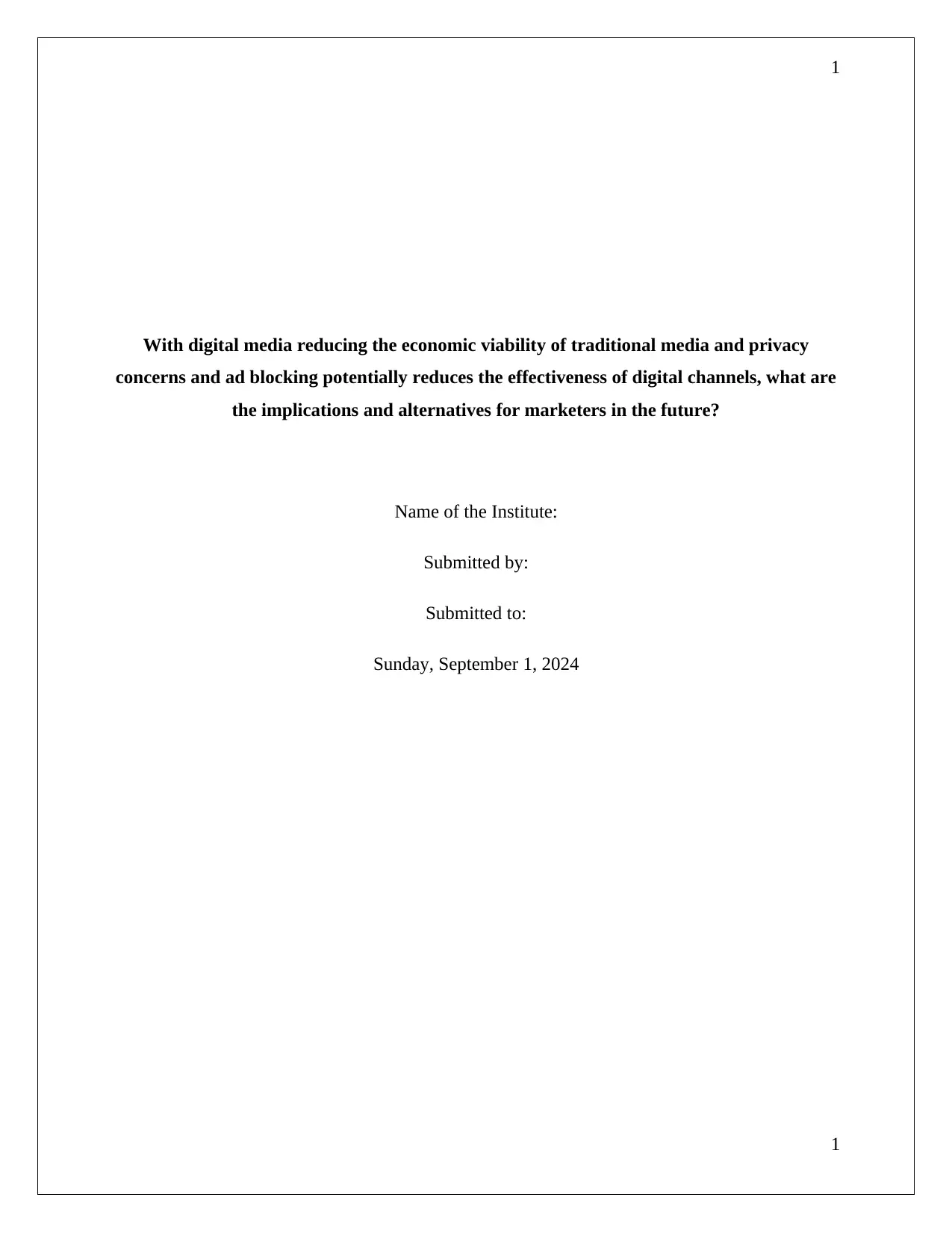
1
With digital media reducing the economic viability of traditional media and privacy
concerns and ad blocking potentially reduces the effectiveness of digital channels, what are
the implications and alternatives for marketers in the future?
Name of the Institute:
Submitted by:
Submitted to:
Sunday, September 1, 2024
1
With digital media reducing the economic viability of traditional media and privacy
concerns and ad blocking potentially reduces the effectiveness of digital channels, what are
the implications and alternatives for marketers in the future?
Name of the Institute:
Submitted by:
Submitted to:
Sunday, September 1, 2024
1
Paraphrase This Document
Need a fresh take? Get an instant paraphrase of this document with our AI Paraphraser
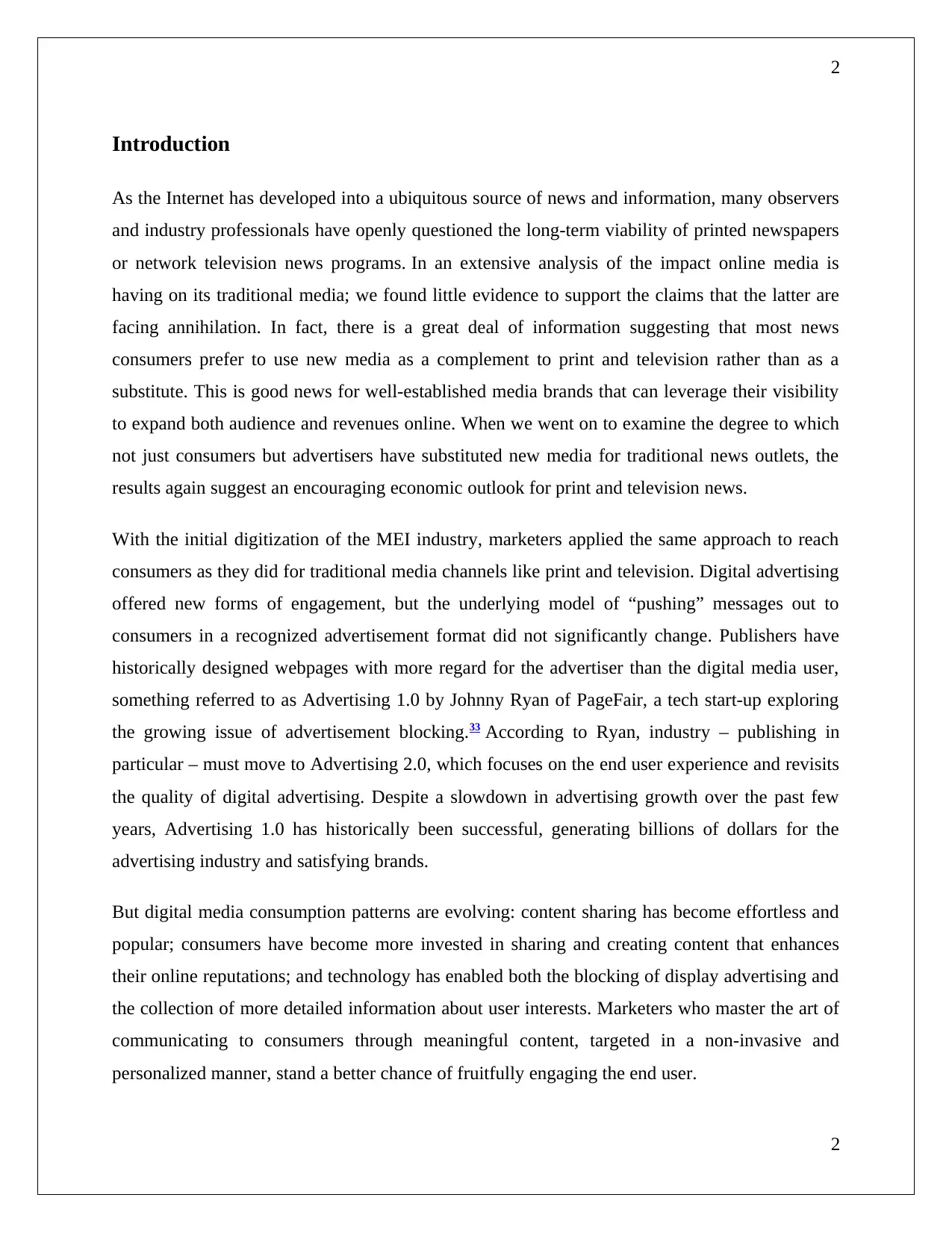
2
Introduction
As the Internet has developed into a ubiquitous source of news and information, many observers
and industry professionals have openly questioned the long-term viability of printed newspapers
or network television news programs. In an extensive analysis of the impact online media is
having on its traditional media; we found little evidence to support the claims that the latter are
facing annihilation. In fact, there is a great deal of information suggesting that most news
consumers prefer to use new media as a complement to print and television rather than as a
substitute. This is good news for well-established media brands that can leverage their visibility
to expand both audience and revenues online. When we went on to examine the degree to which
not just consumers but advertisers have substituted new media for traditional news outlets, the
results again suggest an encouraging economic outlook for print and television news.
With the initial digitization of the MEI industry, marketers applied the same approach to reach
consumers as they did for traditional media channels like print and television. Digital advertising
offered new forms of engagement, but the underlying model of “pushing” messages out to
consumers in a recognized advertisement format did not significantly change. Publishers have
historically designed webpages with more regard for the advertiser than the digital media user,
something referred to as Advertising 1.0 by Johnny Ryan of PageFair, a tech start-up exploring
the growing issue of advertisement blocking.33 According to Ryan, industry – publishing in
particular – must move to Advertising 2.0, which focuses on the end user experience and revisits
the quality of digital advertising. Despite a slowdown in advertising growth over the past few
years, Advertising 1.0 has historically been successful, generating billions of dollars for the
advertising industry and satisfying brands.
But digital media consumption patterns are evolving: content sharing has become effortless and
popular; consumers have become more invested in sharing and creating content that enhances
their online reputations; and technology has enabled both the blocking of display advertising and
the collection of more detailed information about user interests. Marketers who master the art of
communicating to consumers through meaningful content, targeted in a non-invasive and
personalized manner, stand a better chance of fruitfully engaging the end user.
2
Introduction
As the Internet has developed into a ubiquitous source of news and information, many observers
and industry professionals have openly questioned the long-term viability of printed newspapers
or network television news programs. In an extensive analysis of the impact online media is
having on its traditional media; we found little evidence to support the claims that the latter are
facing annihilation. In fact, there is a great deal of information suggesting that most news
consumers prefer to use new media as a complement to print and television rather than as a
substitute. This is good news for well-established media brands that can leverage their visibility
to expand both audience and revenues online. When we went on to examine the degree to which
not just consumers but advertisers have substituted new media for traditional news outlets, the
results again suggest an encouraging economic outlook for print and television news.
With the initial digitization of the MEI industry, marketers applied the same approach to reach
consumers as they did for traditional media channels like print and television. Digital advertising
offered new forms of engagement, but the underlying model of “pushing” messages out to
consumers in a recognized advertisement format did not significantly change. Publishers have
historically designed webpages with more regard for the advertiser than the digital media user,
something referred to as Advertising 1.0 by Johnny Ryan of PageFair, a tech start-up exploring
the growing issue of advertisement blocking.33 According to Ryan, industry – publishing in
particular – must move to Advertising 2.0, which focuses on the end user experience and revisits
the quality of digital advertising. Despite a slowdown in advertising growth over the past few
years, Advertising 1.0 has historically been successful, generating billions of dollars for the
advertising industry and satisfying brands.
But digital media consumption patterns are evolving: content sharing has become effortless and
popular; consumers have become more invested in sharing and creating content that enhances
their online reputations; and technology has enabled both the blocking of display advertising and
the collection of more detailed information about user interests. Marketers who master the art of
communicating to consumers through meaningful content, targeted in a non-invasive and
personalized manner, stand a better chance of fruitfully engaging the end user.
2

3
3
3
⊘ This is a preview!⊘
Do you want full access?
Subscribe today to unlock all pages.

Trusted by 1+ million students worldwide
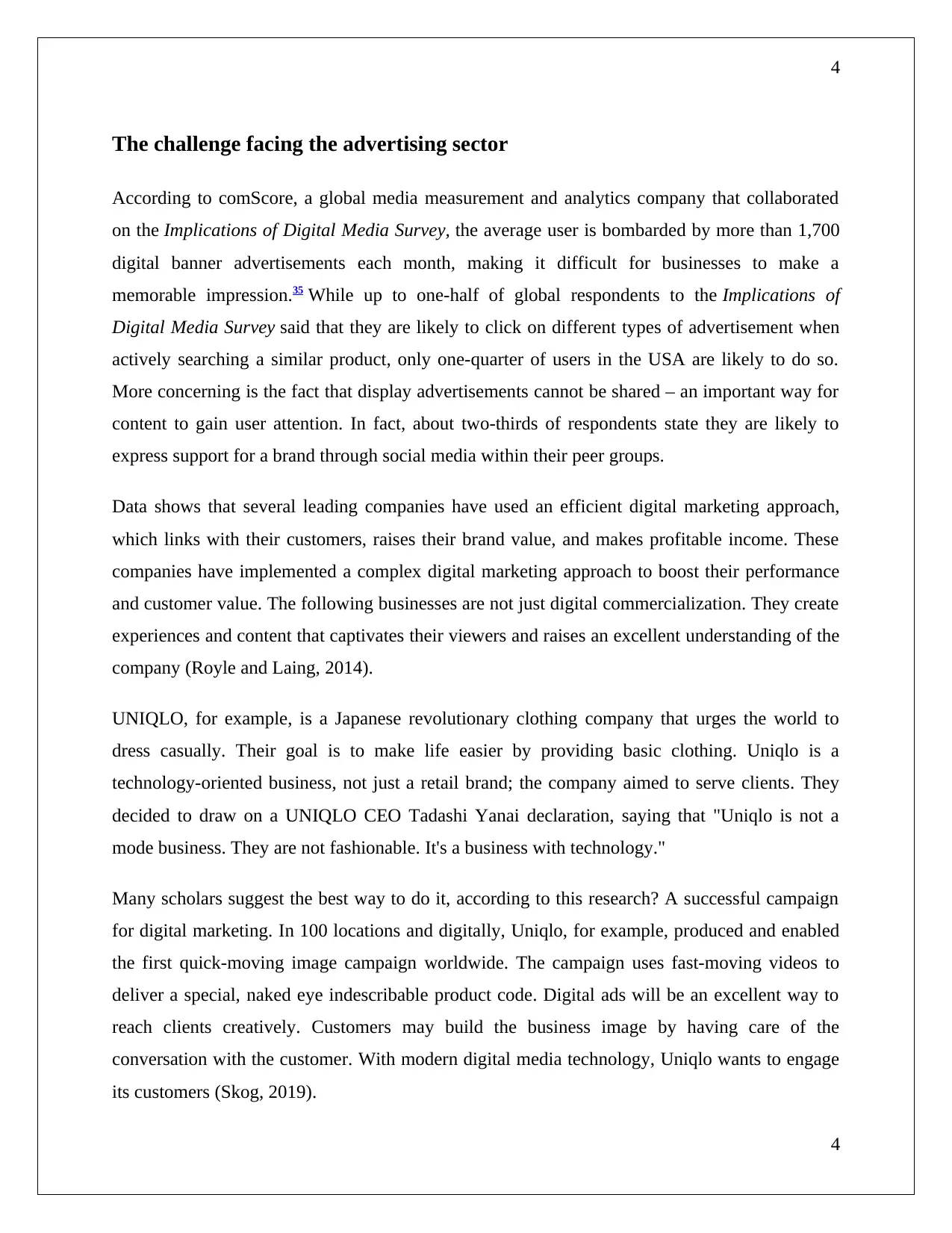
4
The challenge facing the advertising sector
According to comScore, a global media measurement and analytics company that collaborated
on the Implications of Digital Media Survey, the average user is bombarded by more than 1,700
digital banner advertisements each month, making it difficult for businesses to make a
memorable impression.35 While up to one-half of global respondents to the Implications of
Digital Media Survey said that they are likely to click on different types of advertisement when
actively searching a similar product, only one-quarter of users in the USA are likely to do so.
More concerning is the fact that display advertisements cannot be shared – an important way for
content to gain user attention. In fact, about two-thirds of respondents state they are likely to
express support for a brand through social media within their peer groups.
Data shows that several leading companies have used an efficient digital marketing approach,
which links with their customers, raises their brand value, and makes profitable income. These
companies have implemented a complex digital marketing approach to boost their performance
and customer value. The following businesses are not just digital commercialization. They create
experiences and content that captivates their viewers and raises an excellent understanding of the
company (Royle and Laing, 2014).
UNIQLO, for example, is a Japanese revolutionary clothing company that urges the world to
dress casually. Their goal is to make life easier by providing basic clothing. Uniqlo is a
technology-oriented business, not just a retail brand; the company aimed to serve clients. They
decided to draw on a UNIQLO CEO Tadashi Yanai declaration, saying that "Uniqlo is not a
mode business. They are not fashionable. It's a business with technology."
Many scholars suggest the best way to do it, according to this research? A successful campaign
for digital marketing. In 100 locations and digitally, Uniqlo, for example, produced and enabled
the first quick-moving image campaign worldwide. The campaign uses fast-moving videos to
deliver a special, naked eye indescribable product code. Digital ads will be an excellent way to
reach clients creatively. Customers may build the business image by having care of the
conversation with the customer. With modern digital media technology, Uniqlo wants to engage
its customers (Skog, 2019).
4
The challenge facing the advertising sector
According to comScore, a global media measurement and analytics company that collaborated
on the Implications of Digital Media Survey, the average user is bombarded by more than 1,700
digital banner advertisements each month, making it difficult for businesses to make a
memorable impression.35 While up to one-half of global respondents to the Implications of
Digital Media Survey said that they are likely to click on different types of advertisement when
actively searching a similar product, only one-quarter of users in the USA are likely to do so.
More concerning is the fact that display advertisements cannot be shared – an important way for
content to gain user attention. In fact, about two-thirds of respondents state they are likely to
express support for a brand through social media within their peer groups.
Data shows that several leading companies have used an efficient digital marketing approach,
which links with their customers, raises their brand value, and makes profitable income. These
companies have implemented a complex digital marketing approach to boost their performance
and customer value. The following businesses are not just digital commercialization. They create
experiences and content that captivates their viewers and raises an excellent understanding of the
company (Royle and Laing, 2014).
UNIQLO, for example, is a Japanese revolutionary clothing company that urges the world to
dress casually. Their goal is to make life easier by providing basic clothing. Uniqlo is a
technology-oriented business, not just a retail brand; the company aimed to serve clients. They
decided to draw on a UNIQLO CEO Tadashi Yanai declaration, saying that "Uniqlo is not a
mode business. They are not fashionable. It's a business with technology."
Many scholars suggest the best way to do it, according to this research? A successful campaign
for digital marketing. In 100 locations and digitally, Uniqlo, for example, produced and enabled
the first quick-moving image campaign worldwide. The campaign uses fast-moving videos to
deliver a special, naked eye indescribable product code. Digital ads will be an excellent way to
reach clients creatively. Customers may build the business image by having care of the
conversation with the customer. With modern digital media technology, Uniqlo wants to engage
its customers (Skog, 2019).
4
Paraphrase This Document
Need a fresh take? Get an instant paraphrase of this document with our AI Paraphraser
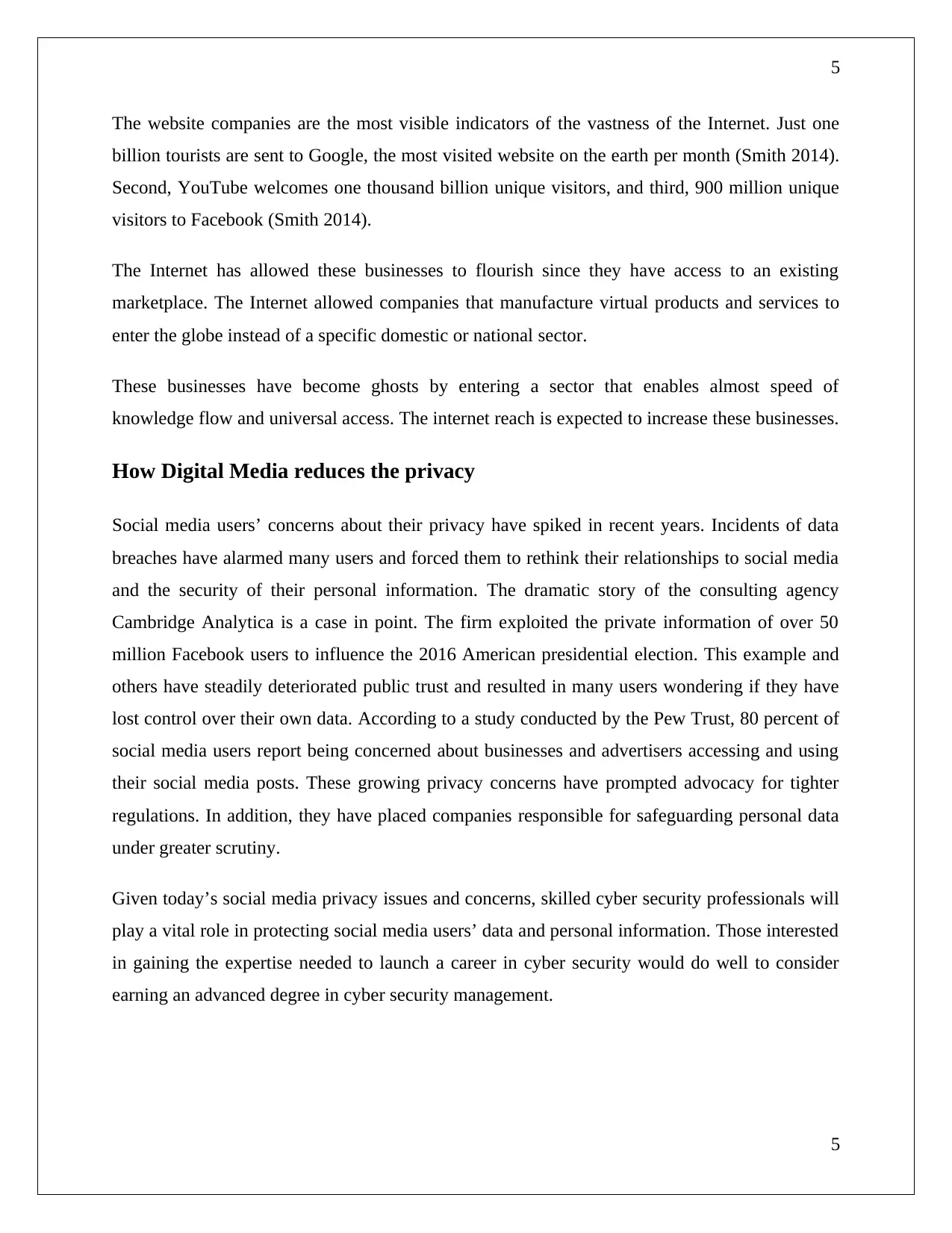
5
The website companies are the most visible indicators of the vastness of the Internet. Just one
billion tourists are sent to Google, the most visited website on the earth per month (Smith 2014).
Second, YouTube welcomes one thousand billion unique visitors, and third, 900 million unique
visitors to Facebook (Smith 2014).
The Internet has allowed these businesses to flourish since they have access to an existing
marketplace. The Internet allowed companies that manufacture virtual products and services to
enter the globe instead of a specific domestic or national sector.
These businesses have become ghosts by entering a sector that enables almost speed of
knowledge flow and universal access. The internet reach is expected to increase these businesses.
How Digital Media reduces the privacy
Social media users’ concerns about their privacy have spiked in recent years. Incidents of data
breaches have alarmed many users and forced them to rethink their relationships to social media
and the security of their personal information. The dramatic story of the consulting agency
Cambridge Analytica is a case in point. The firm exploited the private information of over 50
million Facebook users to influence the 2016 American presidential election. This example and
others have steadily deteriorated public trust and resulted in many users wondering if they have
lost control over their own data. According to a study conducted by the Pew Trust, 80 percent of
social media users report being concerned about businesses and advertisers accessing and using
their social media posts. These growing privacy concerns have prompted advocacy for tighter
regulations. In addition, they have placed companies responsible for safeguarding personal data
under greater scrutiny.
Given today’s social media privacy issues and concerns, skilled cyber security professionals will
play a vital role in protecting social media users’ data and personal information. Those interested
in gaining the expertise needed to launch a career in cyber security would do well to consider
earning an advanced degree in cyber security management.
5
The website companies are the most visible indicators of the vastness of the Internet. Just one
billion tourists are sent to Google, the most visited website on the earth per month (Smith 2014).
Second, YouTube welcomes one thousand billion unique visitors, and third, 900 million unique
visitors to Facebook (Smith 2014).
The Internet has allowed these businesses to flourish since they have access to an existing
marketplace. The Internet allowed companies that manufacture virtual products and services to
enter the globe instead of a specific domestic or national sector.
These businesses have become ghosts by entering a sector that enables almost speed of
knowledge flow and universal access. The internet reach is expected to increase these businesses.
How Digital Media reduces the privacy
Social media users’ concerns about their privacy have spiked in recent years. Incidents of data
breaches have alarmed many users and forced them to rethink their relationships to social media
and the security of their personal information. The dramatic story of the consulting agency
Cambridge Analytica is a case in point. The firm exploited the private information of over 50
million Facebook users to influence the 2016 American presidential election. This example and
others have steadily deteriorated public trust and resulted in many users wondering if they have
lost control over their own data. According to a study conducted by the Pew Trust, 80 percent of
social media users report being concerned about businesses and advertisers accessing and using
their social media posts. These growing privacy concerns have prompted advocacy for tighter
regulations. In addition, they have placed companies responsible for safeguarding personal data
under greater scrutiny.
Given today’s social media privacy issues and concerns, skilled cyber security professionals will
play a vital role in protecting social media users’ data and personal information. Those interested
in gaining the expertise needed to launch a career in cyber security would do well to consider
earning an advanced degree in cyber security management.
5
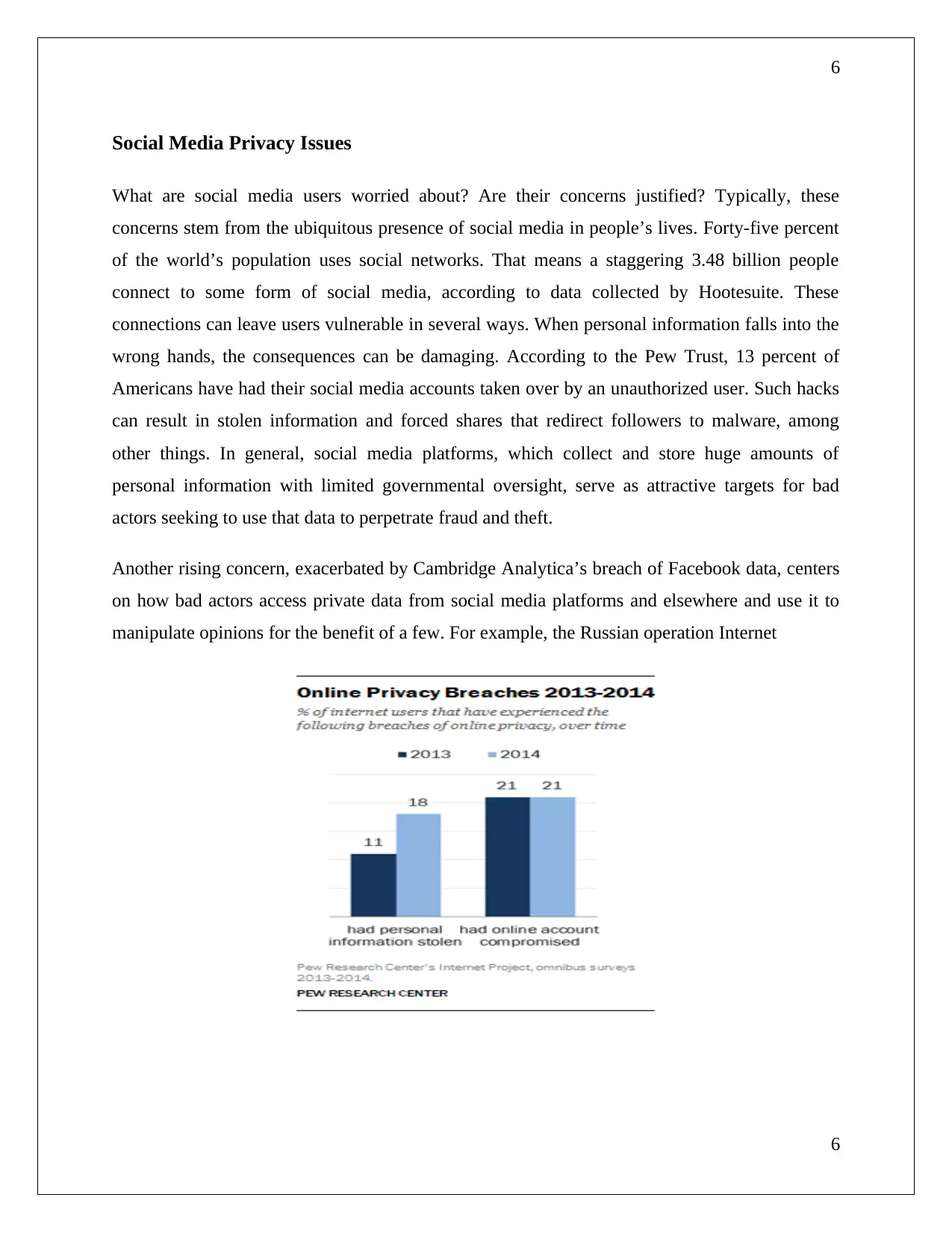
6
Social Media Privacy Issues
What are social media users worried about? Are their concerns justified? Typically, these
concerns stem from the ubiquitous presence of social media in people’s lives. Forty-five percent
of the world’s population uses social networks. That means a staggering 3.48 billion people
connect to some form of social media, according to data collected by Hootesuite. These
connections can leave users vulnerable in several ways. When personal information falls into the
wrong hands, the consequences can be damaging. According to the Pew Trust, 13 percent of
Americans have had their social media accounts taken over by an unauthorized user. Such hacks
can result in stolen information and forced shares that redirect followers to malware, among
other things. In general, social media platforms, which collect and store huge amounts of
personal information with limited governmental oversight, serve as attractive targets for bad
actors seeking to use that data to perpetrate fraud and theft.
Another rising concern, exacerbated by Cambridge Analytica’s breach of Facebook data, centers
on how bad actors access private data from social media platforms and elsewhere and use it to
manipulate opinions for the benefit of a few. For example, the Russian operation Internet
6
Social Media Privacy Issues
What are social media users worried about? Are their concerns justified? Typically, these
concerns stem from the ubiquitous presence of social media in people’s lives. Forty-five percent
of the world’s population uses social networks. That means a staggering 3.48 billion people
connect to some form of social media, according to data collected by Hootesuite. These
connections can leave users vulnerable in several ways. When personal information falls into the
wrong hands, the consequences can be damaging. According to the Pew Trust, 13 percent of
Americans have had their social media accounts taken over by an unauthorized user. Such hacks
can result in stolen information and forced shares that redirect followers to malware, among
other things. In general, social media platforms, which collect and store huge amounts of
personal information with limited governmental oversight, serve as attractive targets for bad
actors seeking to use that data to perpetrate fraud and theft.
Another rising concern, exacerbated by Cambridge Analytica’s breach of Facebook data, centers
on how bad actors access private data from social media platforms and elsewhere and use it to
manipulate opinions for the benefit of a few. For example, the Russian operation Internet
6
⊘ This is a preview!⊘
Do you want full access?
Subscribe today to unlock all pages.

Trusted by 1+ million students worldwide
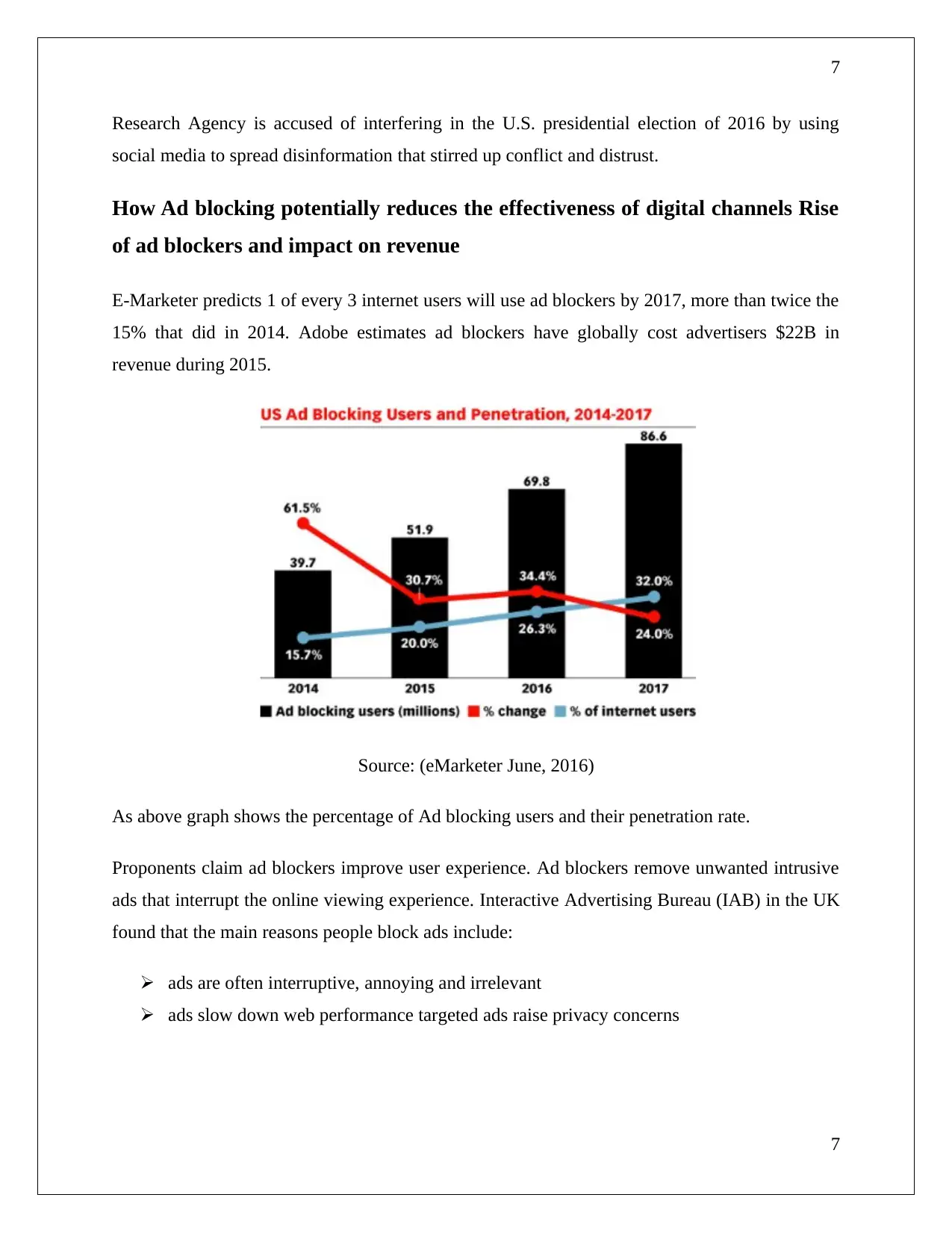
7
Research Agency is accused of interfering in the U.S. presidential election of 2016 by using
social media to spread disinformation that stirred up conflict and distrust.
How Ad blocking potentially reduces the effectiveness of digital channels Rise
of ad blockers and impact on revenue
E-Marketer predicts 1 of every 3 internet users will use ad blockers by 2017, more than twice the
15% that did in 2014. Adobe estimates ad blockers have globally cost advertisers $22B in
revenue during 2015.
Source: (eMarketer June, 2016)
As above graph shows the percentage of Ad blocking users and their penetration rate.
Proponents claim ad blockers improve user experience. Ad blockers remove unwanted intrusive
ads that interrupt the online viewing experience. Interactive Advertising Bureau (IAB) in the UK
found that the main reasons people block ads include:
ads are often interruptive, annoying and irrelevant
ads slow down web performance targeted ads raise privacy concerns
7
Research Agency is accused of interfering in the U.S. presidential election of 2016 by using
social media to spread disinformation that stirred up conflict and distrust.
How Ad blocking potentially reduces the effectiveness of digital channels Rise
of ad blockers and impact on revenue
E-Marketer predicts 1 of every 3 internet users will use ad blockers by 2017, more than twice the
15% that did in 2014. Adobe estimates ad blockers have globally cost advertisers $22B in
revenue during 2015.
Source: (eMarketer June, 2016)
As above graph shows the percentage of Ad blocking users and their penetration rate.
Proponents claim ad blockers improve user experience. Ad blockers remove unwanted intrusive
ads that interrupt the online viewing experience. Interactive Advertising Bureau (IAB) in the UK
found that the main reasons people block ads include:
ads are often interruptive, annoying and irrelevant
ads slow down web performance targeted ads raise privacy concerns
7
Paraphrase This Document
Need a fresh take? Get an instant paraphrase of this document with our AI Paraphraser
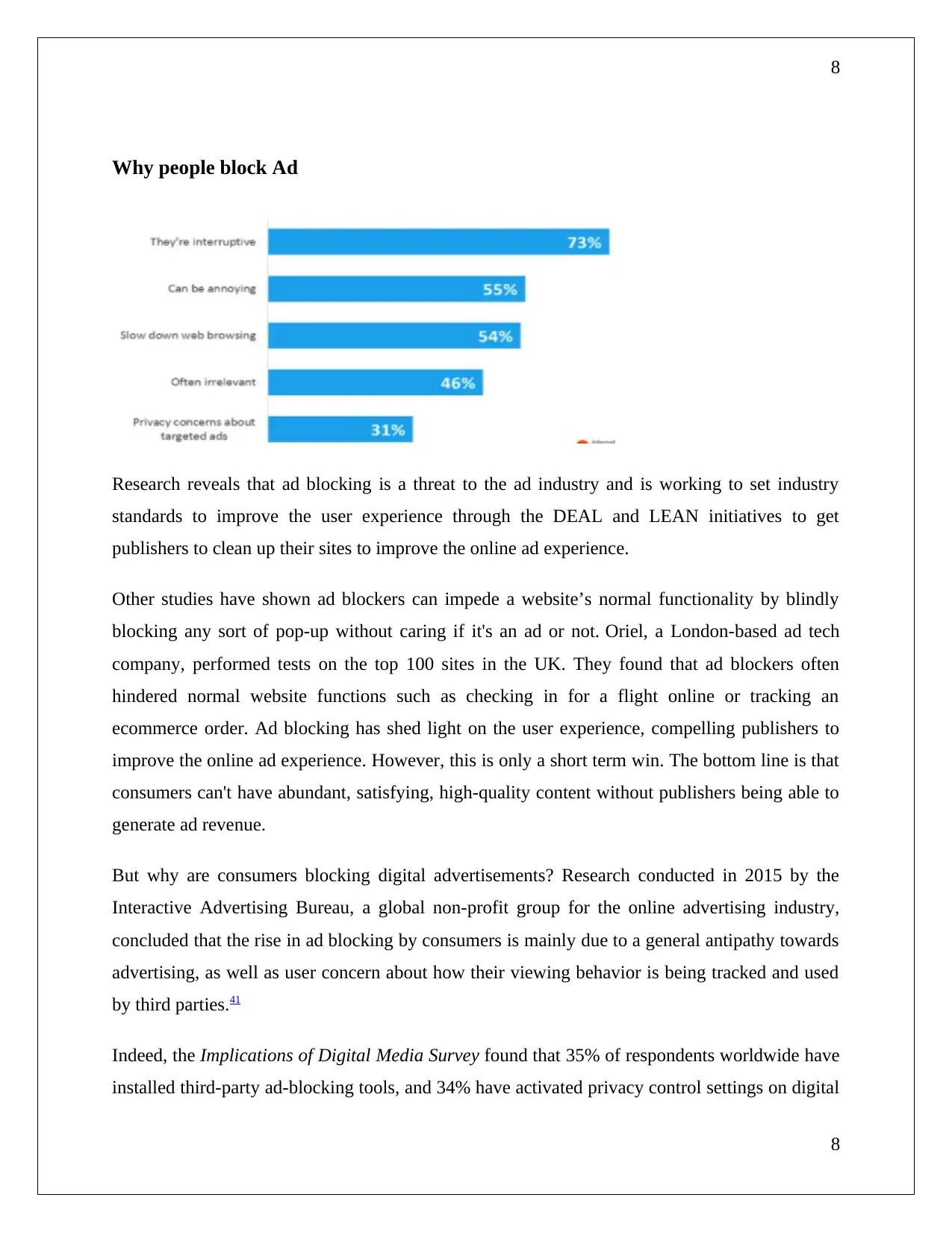
8
Why people block Ad
Research reveals that ad blocking is a threat to the ad industry and is working to set industry
standards to improve the user experience through the DEAL and LEAN initiatives to get
publishers to clean up their sites to improve the online ad experience.
Other studies have shown ad blockers can impede a website’s normal functionality by blindly
blocking any sort of pop-up without caring if it's an ad or not. Oriel, a London-based ad tech
company, performed tests on the top 100 sites in the UK. They found that ad blockers often
hindered normal website functions such as checking in for a flight online or tracking an
ecommerce order. Ad blocking has shed light on the user experience, compelling publishers to
improve the online ad experience. However, this is only a short term win. The bottom line is that
consumers can't have abundant, satisfying, high-quality content without publishers being able to
generate ad revenue.
But why are consumers blocking digital advertisements? Research conducted in 2015 by the
Interactive Advertising Bureau, a global non-profit group for the online advertising industry,
concluded that the rise in ad blocking by consumers is mainly due to a general antipathy towards
advertising, as well as user concern about how their viewing behavior is being tracked and used
by third parties.41
Indeed, the Implications of Digital Media Survey found that 35% of respondents worldwide have
installed third-party ad-blocking tools, and 34% have activated privacy control settings on digital
8
Why people block Ad
Research reveals that ad blocking is a threat to the ad industry and is working to set industry
standards to improve the user experience through the DEAL and LEAN initiatives to get
publishers to clean up their sites to improve the online ad experience.
Other studies have shown ad blockers can impede a website’s normal functionality by blindly
blocking any sort of pop-up without caring if it's an ad or not. Oriel, a London-based ad tech
company, performed tests on the top 100 sites in the UK. They found that ad blockers often
hindered normal website functions such as checking in for a flight online or tracking an
ecommerce order. Ad blocking has shed light on the user experience, compelling publishers to
improve the online ad experience. However, this is only a short term win. The bottom line is that
consumers can't have abundant, satisfying, high-quality content without publishers being able to
generate ad revenue.
But why are consumers blocking digital advertisements? Research conducted in 2015 by the
Interactive Advertising Bureau, a global non-profit group for the online advertising industry,
concluded that the rise in ad blocking by consumers is mainly due to a general antipathy towards
advertising, as well as user concern about how their viewing behavior is being tracked and used
by third parties.41
Indeed, the Implications of Digital Media Survey found that 35% of respondents worldwide have
installed third-party ad-blocking tools, and 34% have activated privacy control settings on digital
8
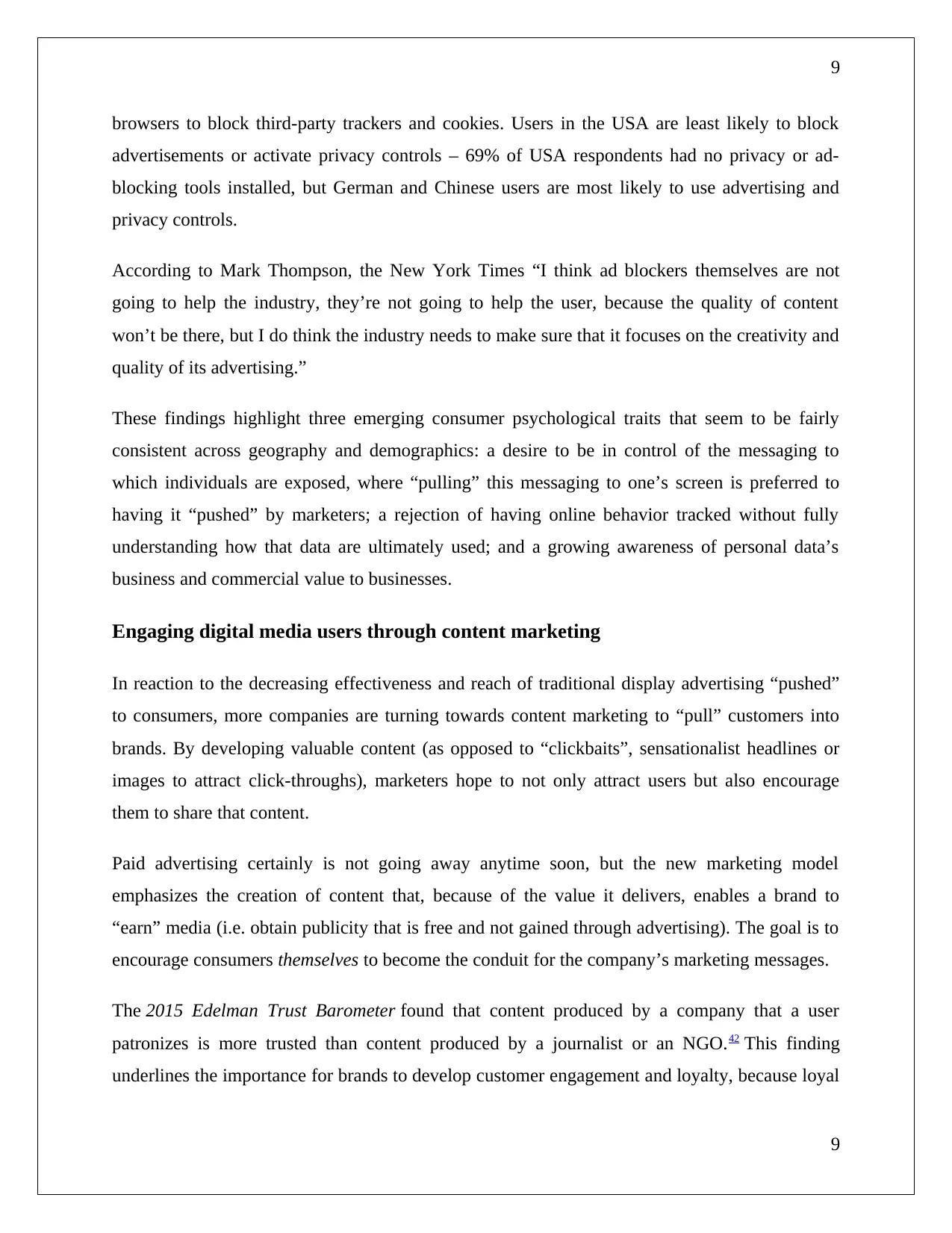
9
browsers to block third-party trackers and cookies. Users in the USA are least likely to block
advertisements or activate privacy controls – 69% of USA respondents had no privacy or ad-
blocking tools installed, but German and Chinese users are most likely to use advertising and
privacy controls.
According to Mark Thompson, the New York Times “I think ad blockers themselves are not
going to help the industry, they’re not going to help the user, because the quality of content
won’t be there, but I do think the industry needs to make sure that it focuses on the creativity and
quality of its advertising.”
These findings highlight three emerging consumer psychological traits that seem to be fairly
consistent across geography and demographics: a desire to be in control of the messaging to
which individuals are exposed, where “pulling” this messaging to one’s screen is preferred to
having it “pushed” by marketers; a rejection of having online behavior tracked without fully
understanding how that data are ultimately used; and a growing awareness of personal data’s
business and commercial value to businesses.
Engaging digital media users through content marketing
In reaction to the decreasing effectiveness and reach of traditional display advertising “pushed”
to consumers, more companies are turning towards content marketing to “pull” customers into
brands. By developing valuable content (as opposed to “clickbaits”, sensationalist headlines or
images to attract click-throughs), marketers hope to not only attract users but also encourage
them to share that content.
Paid advertising certainly is not going away anytime soon, but the new marketing model
emphasizes the creation of content that, because of the value it delivers, enables a brand to
“earn” media (i.e. obtain publicity that is free and not gained through advertising). The goal is to
encourage consumers themselves to become the conduit for the company’s marketing messages.
The 2015 Edelman Trust Barometer found that content produced by a company that a user
patronizes is more trusted than content produced by a journalist or an NGO.42 This finding
underlines the importance for brands to develop customer engagement and loyalty, because loyal
9
browsers to block third-party trackers and cookies. Users in the USA are least likely to block
advertisements or activate privacy controls – 69% of USA respondents had no privacy or ad-
blocking tools installed, but German and Chinese users are most likely to use advertising and
privacy controls.
According to Mark Thompson, the New York Times “I think ad blockers themselves are not
going to help the industry, they’re not going to help the user, because the quality of content
won’t be there, but I do think the industry needs to make sure that it focuses on the creativity and
quality of its advertising.”
These findings highlight three emerging consumer psychological traits that seem to be fairly
consistent across geography and demographics: a desire to be in control of the messaging to
which individuals are exposed, where “pulling” this messaging to one’s screen is preferred to
having it “pushed” by marketers; a rejection of having online behavior tracked without fully
understanding how that data are ultimately used; and a growing awareness of personal data’s
business and commercial value to businesses.
Engaging digital media users through content marketing
In reaction to the decreasing effectiveness and reach of traditional display advertising “pushed”
to consumers, more companies are turning towards content marketing to “pull” customers into
brands. By developing valuable content (as opposed to “clickbaits”, sensationalist headlines or
images to attract click-throughs), marketers hope to not only attract users but also encourage
them to share that content.
Paid advertising certainly is not going away anytime soon, but the new marketing model
emphasizes the creation of content that, because of the value it delivers, enables a brand to
“earn” media (i.e. obtain publicity that is free and not gained through advertising). The goal is to
encourage consumers themselves to become the conduit for the company’s marketing messages.
The 2015 Edelman Trust Barometer found that content produced by a company that a user
patronizes is more trusted than content produced by a journalist or an NGO.42 This finding
underlines the importance for brands to develop customer engagement and loyalty, because loyal
9
⊘ This is a preview!⊘
Do you want full access?
Subscribe today to unlock all pages.

Trusted by 1+ million students worldwide
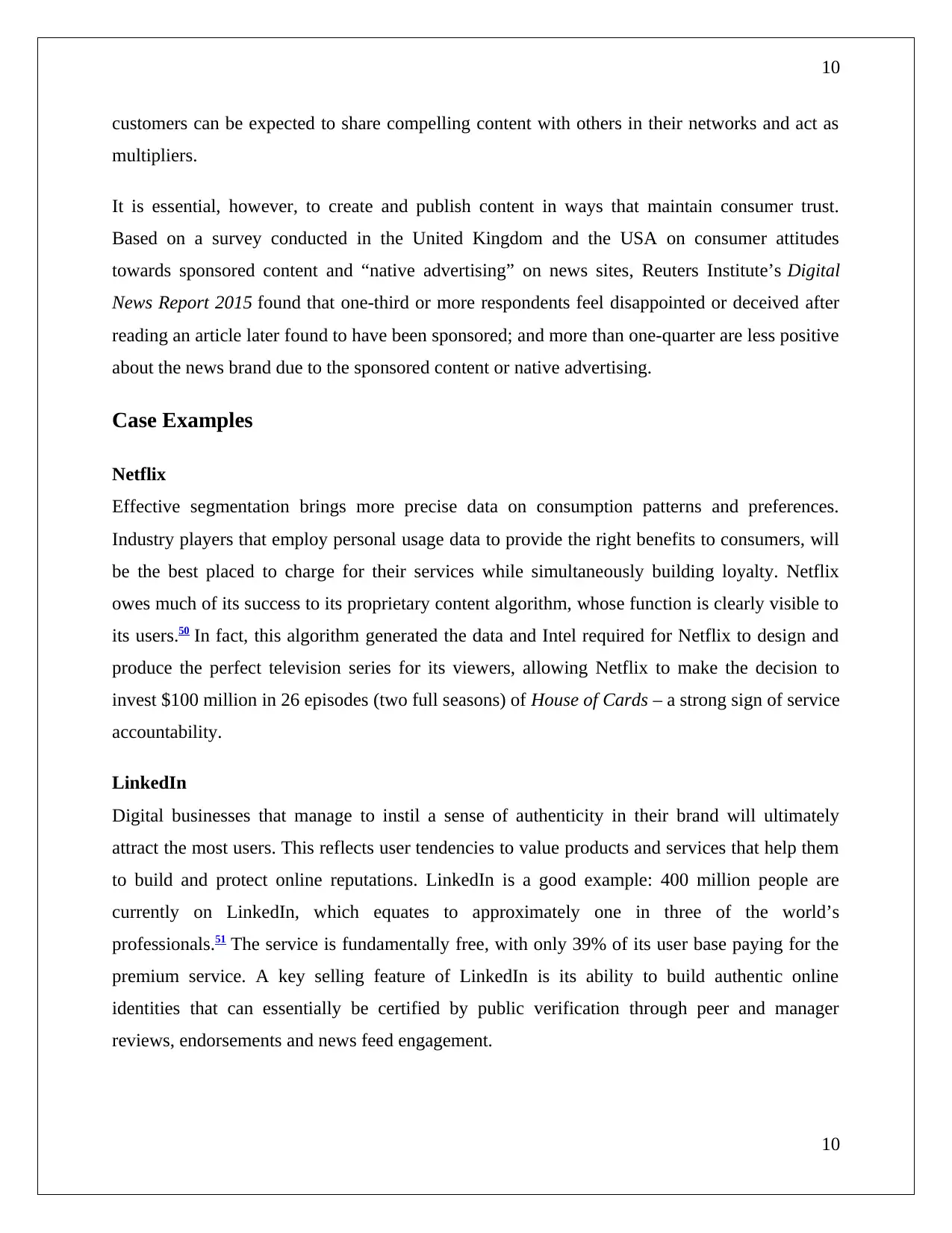
10
customers can be expected to share compelling content with others in their networks and act as
multipliers.
It is essential, however, to create and publish content in ways that maintain consumer trust.
Based on a survey conducted in the United Kingdom and the USA on consumer attitudes
towards sponsored content and “native advertising” on news sites, Reuters Institute’s Digital
News Report 2015 found that one-third or more respondents feel disappointed or deceived after
reading an article later found to have been sponsored; and more than one-quarter are less positive
about the news brand due to the sponsored content or native advertising.
Case Examples
Netflix
Effective segmentation brings more precise data on consumption patterns and preferences.
Industry players that employ personal usage data to provide the right benefits to consumers, will
be the best placed to charge for their services while simultaneously building loyalty. Netflix
owes much of its success to its proprietary content algorithm, whose function is clearly visible to
its users.50 In fact, this algorithm generated the data and Intel required for Netflix to design and
produce the perfect television series for its viewers, allowing Netflix to make the decision to
invest $100 million in 26 episodes (two full seasons) of House of Cards – a strong sign of service
accountability.
LinkedIn
Digital businesses that manage to instil a sense of authenticity in their brand will ultimately
attract the most users. This reflects user tendencies to value products and services that help them
to build and protect online reputations. LinkedIn is a good example: 400 million people are
currently on LinkedIn, which equates to approximately one in three of the world’s
professionals.51 The service is fundamentally free, with only 39% of its user base paying for the
premium service. A key selling feature of LinkedIn is its ability to build authentic online
identities that can essentially be certified by public verification through peer and manager
reviews, endorsements and news feed engagement.
10
customers can be expected to share compelling content with others in their networks and act as
multipliers.
It is essential, however, to create and publish content in ways that maintain consumer trust.
Based on a survey conducted in the United Kingdom and the USA on consumer attitudes
towards sponsored content and “native advertising” on news sites, Reuters Institute’s Digital
News Report 2015 found that one-third or more respondents feel disappointed or deceived after
reading an article later found to have been sponsored; and more than one-quarter are less positive
about the news brand due to the sponsored content or native advertising.
Case Examples
Netflix
Effective segmentation brings more precise data on consumption patterns and preferences.
Industry players that employ personal usage data to provide the right benefits to consumers, will
be the best placed to charge for their services while simultaneously building loyalty. Netflix
owes much of its success to its proprietary content algorithm, whose function is clearly visible to
its users.50 In fact, this algorithm generated the data and Intel required for Netflix to design and
produce the perfect television series for its viewers, allowing Netflix to make the decision to
invest $100 million in 26 episodes (two full seasons) of House of Cards – a strong sign of service
accountability.
Digital businesses that manage to instil a sense of authenticity in their brand will ultimately
attract the most users. This reflects user tendencies to value products and services that help them
to build and protect online reputations. LinkedIn is a good example: 400 million people are
currently on LinkedIn, which equates to approximately one in three of the world’s
professionals.51 The service is fundamentally free, with only 39% of its user base paying for the
premium service. A key selling feature of LinkedIn is its ability to build authentic online
identities that can essentially be certified by public verification through peer and manager
reviews, endorsements and news feed engagement.
10
Paraphrase This Document
Need a fresh take? Get an instant paraphrase of this document with our AI Paraphraser
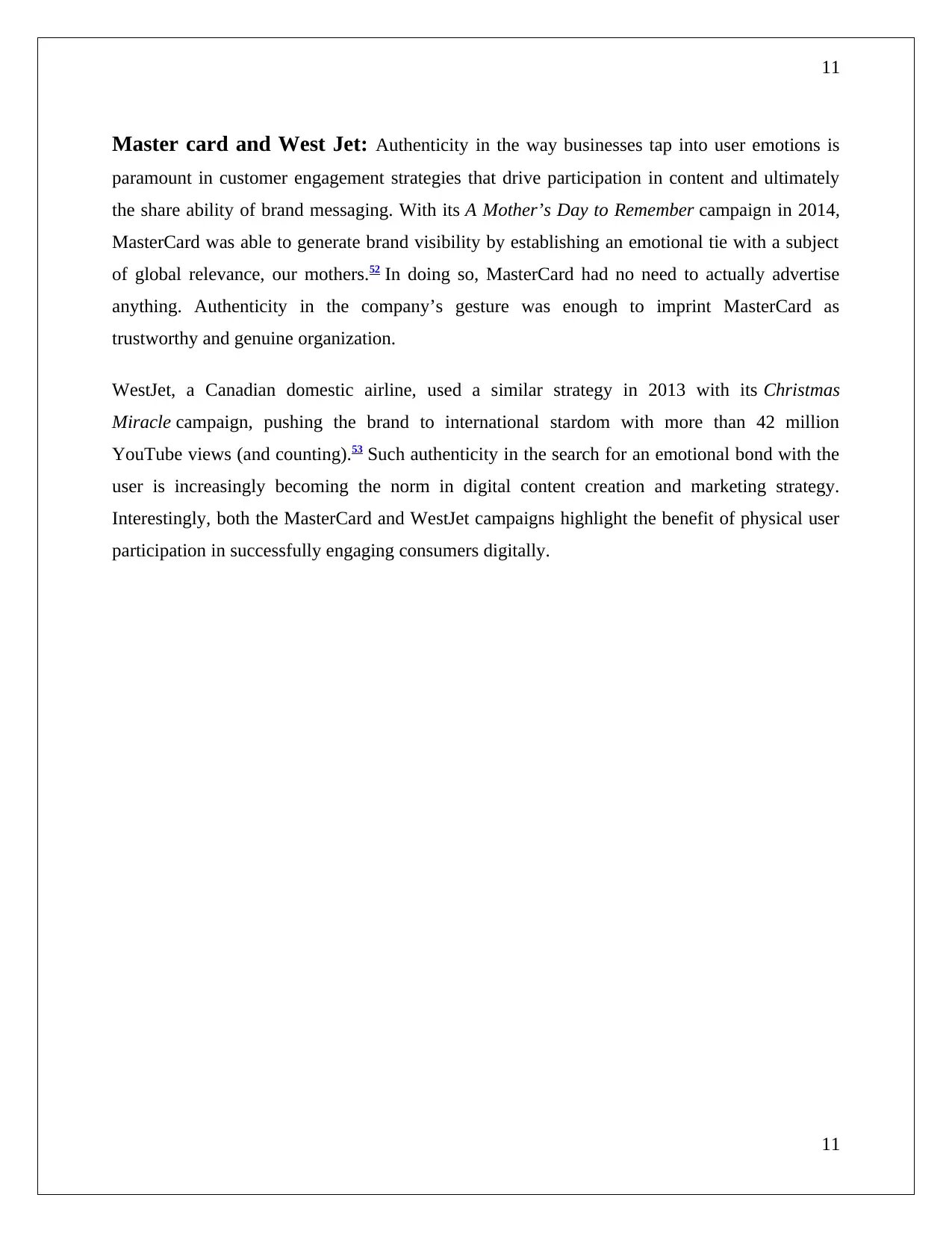
11
Master card and West Jet: Authenticity in the way businesses tap into user emotions is
paramount in customer engagement strategies that drive participation in content and ultimately
the share ability of brand messaging. With its A Mother’s Day to Remember campaign in 2014,
MasterCard was able to generate brand visibility by establishing an emotional tie with a subject
of global relevance, our mothers.52 In doing so, MasterCard had no need to actually advertise
anything. Authenticity in the company’s gesture was enough to imprint MasterCard as
trustworthy and genuine organization.
WestJet, a Canadian domestic airline, used a similar strategy in 2013 with its Christmas
Miracle campaign, pushing the brand to international stardom with more than 42 million
YouTube views (and counting).53 Such authenticity in the search for an emotional bond with the
user is increasingly becoming the norm in digital content creation and marketing strategy.
Interestingly, both the MasterCard and WestJet campaigns highlight the benefit of physical user
participation in successfully engaging consumers digitally.
11
Master card and West Jet: Authenticity in the way businesses tap into user emotions is
paramount in customer engagement strategies that drive participation in content and ultimately
the share ability of brand messaging. With its A Mother’s Day to Remember campaign in 2014,
MasterCard was able to generate brand visibility by establishing an emotional tie with a subject
of global relevance, our mothers.52 In doing so, MasterCard had no need to actually advertise
anything. Authenticity in the company’s gesture was enough to imprint MasterCard as
trustworthy and genuine organization.
WestJet, a Canadian domestic airline, used a similar strategy in 2013 with its Christmas
Miracle campaign, pushing the brand to international stardom with more than 42 million
YouTube views (and counting).53 Such authenticity in the search for an emotional bond with the
user is increasingly becoming the norm in digital content creation and marketing strategy.
Interestingly, both the MasterCard and WestJet campaigns highlight the benefit of physical user
participation in successfully engaging consumers digitally.
11
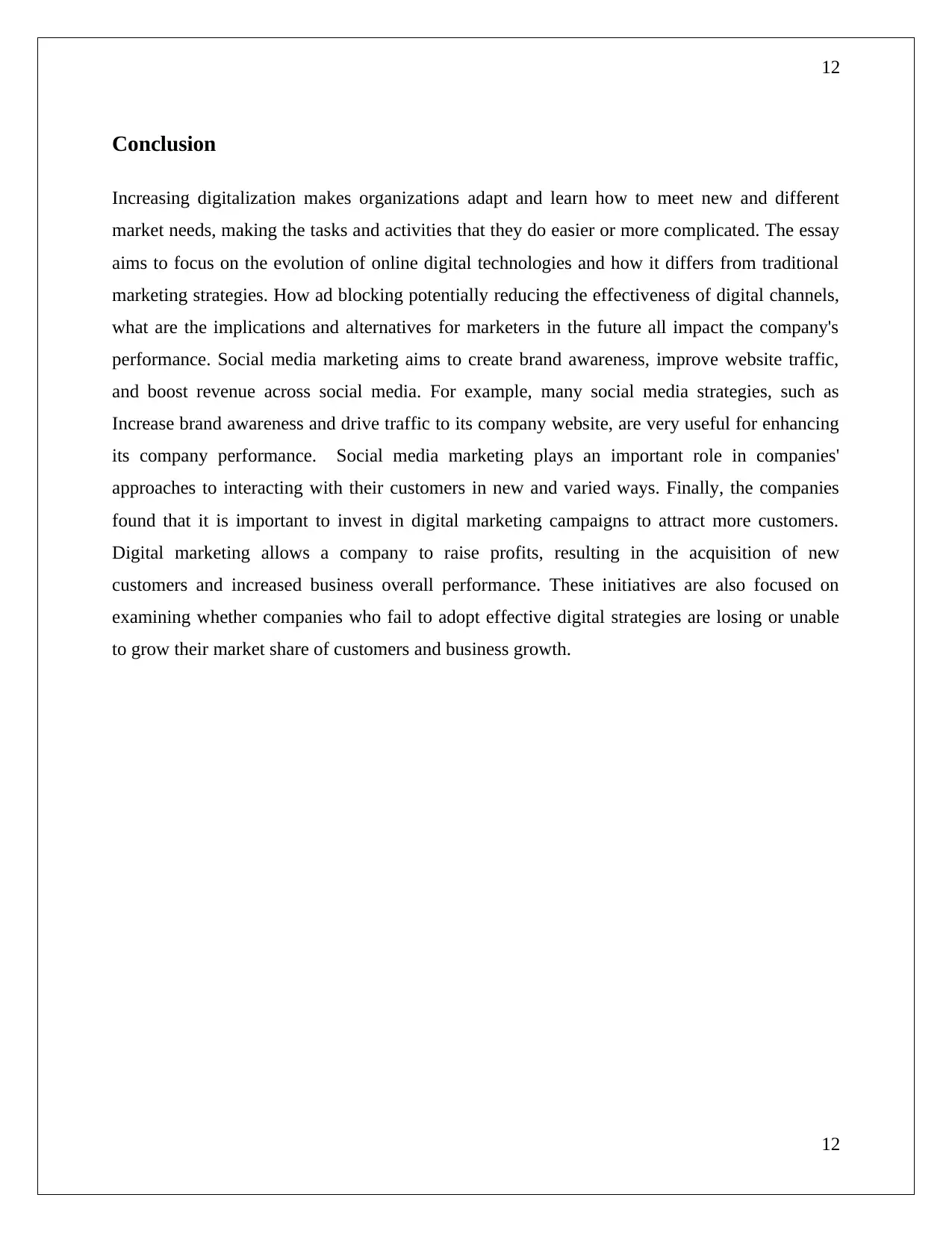
12
Conclusion
Increasing digitalization makes organizations adapt and learn how to meet new and different
market needs, making the tasks and activities that they do easier or more complicated. The essay
aims to focus on the evolution of online digital technologies and how it differs from traditional
marketing strategies. How ad blocking potentially reducing the effectiveness of digital channels,
what are the implications and alternatives for marketers in the future all impact the company's
performance. Social media marketing aims to create brand awareness, improve website traffic,
and boost revenue across social media. For example, many social media strategies, such as
Increase brand awareness and drive traffic to its company website, are very useful for enhancing
its company performance. Social media marketing plays an important role in companies'
approaches to interacting with their customers in new and varied ways. Finally, the companies
found that it is important to invest in digital marketing campaigns to attract more customers.
Digital marketing allows a company to raise profits, resulting in the acquisition of new
customers and increased business overall performance. These initiatives are also focused on
examining whether companies who fail to adopt effective digital strategies are losing or unable
to grow their market share of customers and business growth.
12
Conclusion
Increasing digitalization makes organizations adapt and learn how to meet new and different
market needs, making the tasks and activities that they do easier or more complicated. The essay
aims to focus on the evolution of online digital technologies and how it differs from traditional
marketing strategies. How ad blocking potentially reducing the effectiveness of digital channels,
what are the implications and alternatives for marketers in the future all impact the company's
performance. Social media marketing aims to create brand awareness, improve website traffic,
and boost revenue across social media. For example, many social media strategies, such as
Increase brand awareness and drive traffic to its company website, are very useful for enhancing
its company performance. Social media marketing plays an important role in companies'
approaches to interacting with their customers in new and varied ways. Finally, the companies
found that it is important to invest in digital marketing campaigns to attract more customers.
Digital marketing allows a company to raise profits, resulting in the acquisition of new
customers and increased business overall performance. These initiatives are also focused on
examining whether companies who fail to adopt effective digital strategies are losing or unable
to grow their market share of customers and business growth.
12
⊘ This is a preview!⊘
Do you want full access?
Subscribe today to unlock all pages.

Trusted by 1+ million students worldwide
1 out of 14
Related Documents
Your All-in-One AI-Powered Toolkit for Academic Success.
+13062052269
info@desklib.com
Available 24*7 on WhatsApp / Email
![[object Object]](/_next/static/media/star-bottom.7253800d.svg)
Unlock your academic potential
Copyright © 2020–2025 A2Z Services. All Rights Reserved. Developed and managed by ZUCOL.





